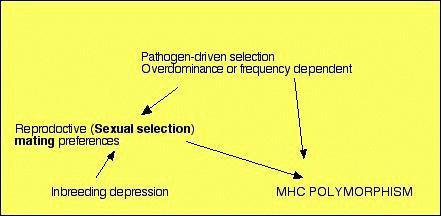
MHC
The major histocompatibility complex loci (MHC) play an interesting role in vertebrate mating systems. Their primary role, of course, is in mediating a vertebratešs immune response to diseases and parasites. MHC loci are hypervariable. Variability is maintained by heterozygote advantage, rare-allele advantage, and disassortative mating. Many mammals detect MHC genotype by smell, giving them cues that can be used in behvioral decisions, including mate choice. Because variablity in MHC is a presumed advantage, heritability should be high. Honest signalling may be desirable or at least unavoidable. These are the ultimate good-genes.

Figure 1, redrawn from Potts and Wakefield (1993) shows the interaction between factors that lead to MHC polymorphism. Note the prominent position of sexual selection and mating preferences in these interactions.
Hypothetically, pathogens evolve to evade common MHC genotypes, giving rare MHC genotypes a selective advantage. MHC heterozygotes express twice the number of alleles as homozygotes, presumably giving heterozygotes a broader range of resistance to disease.
Potts, W. K. and Wakeland, E. K. 1993. Evolution of MHC genetic diversity: a tale of incest, pestilence, and sexual preference. Trends in genetics 9:408-412
Jordan, W. C. and M. W. Burford. 1998. New perspectives on mate choice and the MHC. Heredity 81:239-245.
Penn, D. J. and W. K. Potts 1999. The evolution of mating preferences and the major histocompatibility complex genes. Am. Nat. 153:145-164.
Yamazaki, K., Beauchamp, G. K., A. Singer, J. Bard, and E. A. Boyse. 1999. Odortypes: Their origin and composition. P. N. A. S. (USA) 96:1522-1525.